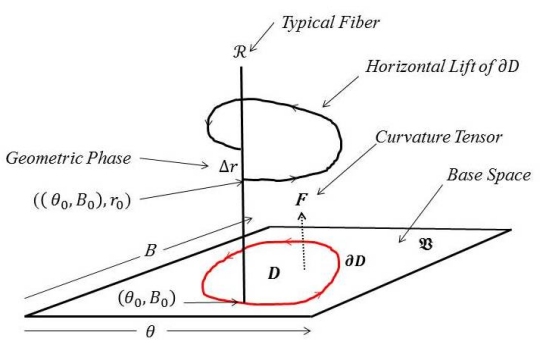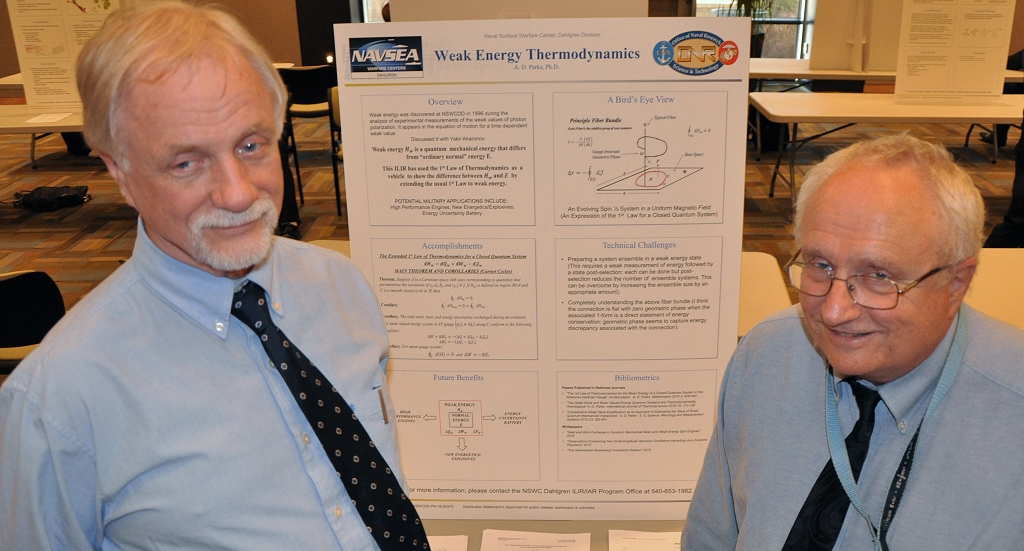 This diagram describes the energy gauge field and geometric phase related to weak energy thermodynamics. Navy scientist Dr. Dan Parks presented the diagram - his model of the principle fiber bundle - at a November 2016 poster session featuring Naval Surface Warfare Center Dahlgren Division (NSWCDD) In-house Laboratory Independent Research (ILIR) projects. Parks received the command's ILIR Excellence Award for his research on weak energy and its properties at the event. Potential military applications of weak energy includes new energetics and explosives as well as significant impact to high performance engines and the storage of power for warfighters deployed to dangerous and remote regions. (U.S. Navy diagram/Released)
This diagram describes the energy gauge field and geometric phase related to weak energy thermodynamics. Navy scientist Dr. Dan Parks presented the diagram - his model of the principle fiber bundle - at a November 2016 poster session featuring Naval Surface Warfare Center Dahlgren Division (NSWCDD) In-house Laboratory Independent Research (ILIR) projects. Parks received the command's ILIR Excellence Award for his research on weak energy and its properties at the event. Potential military applications of weak energy includes new energetics and explosives as well as significant impact to high performance engines and the storage of power for warfighters deployed to dangerous and remote regions. (U.S. Navy diagram/Released)DAHLGREN, Va. (Nov. 30, 2016)—A Navy scientist was awarded for his groundbreaking research on a new form of quantum mechanical energy, Naval Surface Warfare Center Dahlgren Division (NSWCDD) announced Nov. 29.
Dr. Dan Parks received the 2016 NSWCDD In-house Laboratory Independent Research (ILIR) Excellence Award for his research over the course of ten years on weak energy and its properties.
"From a Navy applications perspective, I believe that weak energy can provide enhancements to energetics, possible new energy transfer techniques, and devices that can perform more work than is possible by comparable traditional energy systems," said Parks, who discovered weak energy during an optics experiment in 1996.
The NSWCDD Electromagnetic and Sensor Systems Department principal scientist has been busy researching weak energy ever since.
"I have found that it is important in many areas in theoretical quantum physics," said Parks, who refers to weak energy as "a peculiar kind of quantum mechanical energy".
He elucidated the peculiarities of weak energy—and the relationship of weak energy to thermodynamics—during the End of (Fiscal) Year Review Poster Session featuring NSWCDD ILIR projects at the University of Mary Washington Dahlgren Campus, Nov. 3.
Potential military applications of weak energy includes new energetics and explosives as well as significant impact to high performance engines and the storage of power for warfighters deployed to dangerous and remote regions.
"This project showed that the traditional first law of thermodynamics for closed quantum systems must be extended to include weak energy systems," Parks told the session's attendees, explaining that, "the traditional first law is a special case of the new extended first law."
The session focused on a small portfolio of ILIR and Independent Applied Research (IAR) programs that ILIR/IAR Program Director Dr. Jeffrey Solka manages with funding from the Office of Naval Research (ONR).
"The NSWC Dahlgren Division ILIR/IAR Program helps our workforce actively participate in the creation of future naval innovations," said Solka. "Such innovations often determine success or failure in naval conflicts that may occur 10 to 20 years in the future."
Solka announces the ILIR/IAR Excellence Award—also known as the ILIR/IAR Project of the Year Award—annually after a careful examination based on an analysis of projects and their accomplishments throughout the previous fiscal year. Consequently, Solka presented this year's award to Parks at the poster session for "outstanding performance and lasting contribution" on weak energy thermodynamics.
"ILIR program support and trust in me as a researcher has enabled me to increase my understanding of this peculiar form of energy." said Parks. "I am grateful for the basic research opportunities afforded me by the NSWC Dahlgren Division ILIR program."
The science and technology strategy developed by ONR provides the direction for leveraging Navy advances in knowledge and technology.
This ONR science and technology strategy seeks to achieve innovation through two programs of research. The first research program—Discovery and Invention (6.1 and 6.2)—includes elements of basic and applied research. The second program—Exploitation and Deployment to meet Future Naval Capabilities (6.2 and 6.3)—features elements of applied and advanced development research.
The ILIR Discovery and Invention Program's funding category (6.1 and 6.2) provides for discretionary basic research at participating Navy laboratories and warfare centers. The ILIR program provides Navy laboratories and warfare centers with the means to support important or promising basic research in the areas of their assigned missions. The funding enables a cadre of active research scientists to apply their research results to problems of naval interest while encouraging cooperation with universities, private industry, and other defense department laboratories.
In addition to the Weak Energy Thermodynamics ILIR Project, principal investigators presented the following projects at the NSWCDD ILIR/IAR Year End Poster Session:
. Ultrathin Light-Weight Multifunctional Metafilms
• Examination of Human Performance Characteristics Using Eye Tracking and 3D Motion Capture Gaze-Supported Gestures
• Defining the Realizable Spectral Density Matrix Space for Multiple-Input-Multiple-Output Vibration Tests
• Electrochemical Destruction of Bulk Chemical Warfare Agents
• Density-Based Data Stream Clustering
• High Affinity, Easily Strippable Surfactants For Nanoparticle Deposition
• Broadband Prewhitening Filtering Framework to Improve Beamforming Detection Performance in Linear Arrays under Reduced Snapshot Support Conditions
• Diagnosing Degenerate Forms in Software
• Error Reconciliation in Quantum Cryptography
• Synthesis and Characterization of Carbon Nanotube-Metal Organic Framework Composites
• Predicting Liquid Absorption in Polymers
• Electromagnetic Response of Stress-Grown Carbon Nanotubes
• Attributed Geo-Temporal Inference
• Topological Data Analysis
• Automated Storytelling
• Periodicity and Regularity within the 3x+1 Dynamical System
• Dynamical Non-locality Induced Effect in Quantum Interference
• Background Oriented Schlieren Imaging for the Quantitative Analysis of Blast Profiles
• Cyber Security for the Internet of Things



